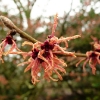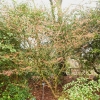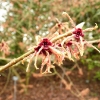Features
Large, oval mid green leaves cover this shrub in spring and summer. Young stems are covered in fine hairs. In autumn the leaves turn a vibrant orange/red and fall. They are followed in winter by flowers with coppery-orange, crinkled, strap-like petals with deep red-purple centres, borne on the bare stems. The flowers are slightly fragrant.
What to use it for
A very useful, low maintenance plant for winter interest, as a focal point or in a bed/border. Particularly suits cottage style gardens and woodland planting schemes. Stems can be cut and brought indoors for flower arranging. Just make sure you plant it in a location where you can appreciate the winter scent.
How to look after it
If your plant has been grafted then you should plant it so the graft union is just above soil level. Check it regularly to remove any suckers growing from the rootstock. Pull the suckers off by hand so the whole sucker is removed from the stem or root (this will help to prevent regrowth).
Other than this, Hamamelis x intermedia ‘Hiltingbury’ is a very low maintenance plant.
How to prune it
Pruning can be done in early spring as the flowers fade (but before the leaves establish) and should be kept to a minimum. If branches need to be removed (eg due to death, disease, weakness or damage) they should be cut back to young, healthy growth.
Hard pruning can be done, however the plant will recover slowly and if the plant has been grafted then the rootstock may start to take over.
How to propagate it
The easiest way to propagate this plant is by simple layering in spring.
Alternatively you can try taking softwood cuttings in spring. Take nodal stem-tip cuttings from new growth, use hormone rooting compound and apply bottom heat of 12-20°C. Ensure that the cuttings are kept moist and in a frost-free place over winter.
Grafting is the most common commercial method of propagating witch hazels and should be done in late summer. Attach the scion of Hamamelis x intermedia ‘Hiltingbury’ onto a 2 year old rootstock of Hamamelis virginiana, using a spliced side graft or by chip budding. Make the graft as low as possible to reduce the risk of suckers growing from the rootstock. The resulting plant should flower within 5 years.
Common problems
Generally pest and disease free, although it may be affected by coral spot.
Other useful information
Hamamelis x intermedia plants are hybrids of Hamamelis mollis and Hamamelis japonica. This cultivar was was hybridised by the Hillier nurseries and is named after one of their previous sites at Hiltingbury, Hampshire, UK.
The genus name ‘Hamamelis‘ is Greek for ‘together with fruit’ and is thought to refer to the fact that the flowers, fruit and leaf buds are, unusually, all present on the plant at the same time in late winter. The species name ‘mollis‘ means ’soft’.
The term ‘witch hazel’ stems from the comon name used in Britain since the 16th century for Ulmus glabra, the ‘wych elm’. ‘Wych’ means ‘pliable’ and relates to the use of the elm’s bendy stems to make divining/dowsing rods (the magical connotations of which may explain the spelling change from wych to witch). The leaves resemble the foliage of hazel trees (although neither Ulmus nor Hamamelis species are related to hazels). Following the colonisation of North America, the native Hamamelis virginiana was noted to have a similar form to the wych elm, and the common name ‘witch hazel’ was adopted for it.










